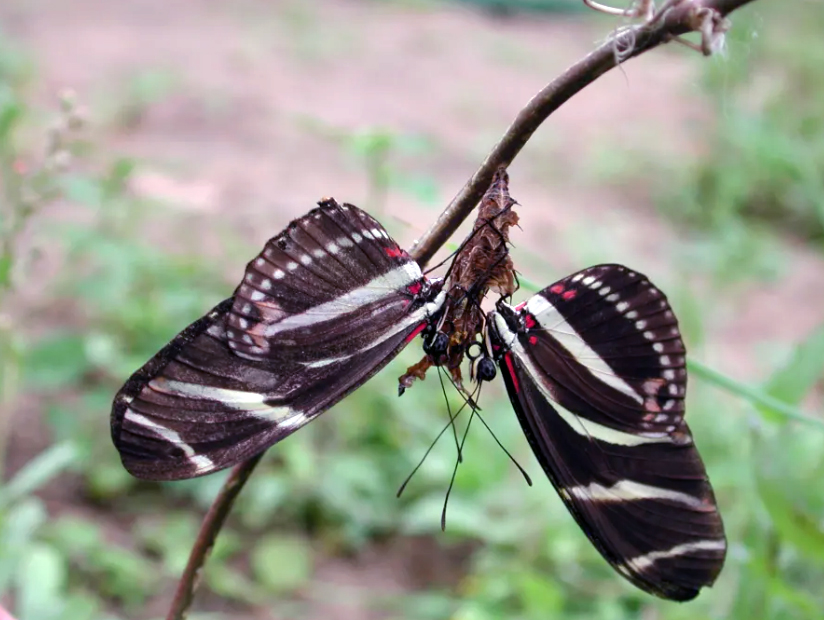
As butterflies flit among flowers, they don’t all see blossoms the same way. In a phenomenon called sexually dimorphic vision, females of some butterfly species perceive ultraviolet color while the males see light and dark.
A team of University of California, Irvine, Texas A&M University and University of Texas at Austin biologists led by the Texas A&M Department of Biology’s Dr. Mahul Chakraborty has discovered that, in at least one species, the variation results from a vision gene’s jump onto a sex chromosome. Their study, which appears in Proceedings of the National Academy of Sciences, is the first known finding that this kind of genetic change causes sexually dimorphic vision.
Some Heliconius butterfly species see ultraviolet color, an array wider than the visible light spectrum that humans perceive. A substance produced by the opsin gene accounts for these butterflies’ visual capacity. In one class of Heliconius species with sexually dimorphic vision, only females see ultraviolet colors.
In searching for the genetic mechanism behind this difference, the researchers selected as their subject Heliconius charithonia, or Zebra Longwing butterfly, whose visual capacity is sexually dimorphic. When the biologists finished assembling the first complete genome for this species, they discovered its W — or female — chromosome contained the opsin gene.
“This is the first known instance where dimorphic color vision in animals comes from a single gene moving to a sex chromosome,” said Chakraborty, who served as first author for the paper. “Besides the discovery’s scientific significance, it highlights the complexities of automated genetic sequencing and the crucial role of validation.”
Chakraborty performed much of his work on the project as a postdoctoral researcher in the laboratories of co-corresponding authors Dr. Adriana Briscoe and Dr. J.J. Emerson at UC Irvine prior to joining the Texas A&M faculty in 2022.
Scientists believe the vision difference may be the reason that females and males within some butterfly species feed on different types of flowers. So far, the only other animals known to have sexually dimorphic vision are some kinds of primates with red-green polymorphism, such as humans and squirrel monkeys.
There’s another twist to the story, according to Dr. Larry Gilbert, a professor of integrative biology at UT Austin and director of the Brackenridge Field Laboratory, where Zebra Longwings occur in the wild and also are maintained by Gilbert in a tropical greenhouse for such research at UT Austin and elsewhere. Gilbert notes that adult males of some species of Heliconius will wait for the moment a female emerges from her chrysalis and then immediately attempt to mate with her as a way to outcompete other males for the chance — a strategy known as pupal mating.
“For now, we are faced with an additional intriguing mystery, as only Heliconius species with males that locate and sit on female pupae — in other words, engage in pupal mating — have opsin genes moved to the W chromosome,” Gilbert said.

Because previously assembled genomes for Heliconius charithonia were fragmentary, none included the W chromosome, whose highly repetitive code can pose stumbling blocks for automatic sequencing. When the UCI researchers began their work by automatically sequencing the species genome, it failed to reveal all expected copies of the opsin gene, which plays a vital role in visual perception of light and color. Undeterred, they next examined the coding manually.
“I went through every bit of the sequencing,” said Angelica Lara, who was an ecology and evolutionary biology undergraduate when she began working with the investigative team. She continued to participate in the project as a post-baccalaureate researcher after receiving her degree. “I still couldn’t find the opsin after all that review. Then I realized a part of the code for the W chromosome had not been well-formatted, and I believed the opsin had to be located there.”
Lara’s finding cued Chakraborty to examine that segment more closely. It turned out the automatic sequencing had dropped that section of the chromosome’s coding, likely stymied by its repetitiveness. Restoring it revealed the opsin gene, and the team confirmed the finding with additional tests.
"Although we have uncovered the genetic mechanism underlying female-specific UV color vision, we still need pieces of the puzzle of how this trait evolved in females,” Chakraborty said. “For example, we still do not know what ecological factors make the ability to distinguish UV wavelengths adaptive for females but not males. Several hypotheses are being tested. One prediction is that flowers that the females feed on are more clearly identifiable or distinguishable by females under UV light. We also need to determine whether the W-linked UV opsin evolved from an autosomal opsin or vice versa. The answer to this question will demystify the exact mutational steps underlying the evolutionary origin of this sexually dimorphic trait.”
The team's research was supported by the National Science Foundation, the National Institutes of Health, the UCI Optical Biology Core Facility and Chakraborty's start-up funding from Texas A&M.
Learn more about the Chakraborty Lab and related research.
This story is adapted from press releases from the University of California, Irvine, and the UT Austin College of Natural Sciences.

